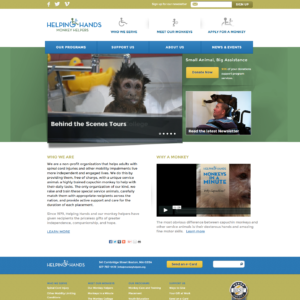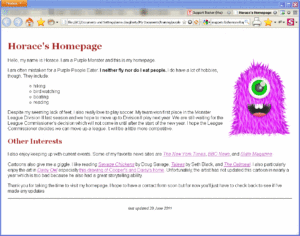– My roles: Content Strategist, IA, Trainer, Front-end Developer –
Challenge
The Monkey Helpers project was already in progress when I joined Rad Campaign.
I used my skills as a content strategist and information architect to understand the organization’s needs.
It turned out that they had content needs and technical needs that hadn’t come to light yet.
Approach
 Rad Campaign’s waterfall process and deliverables were unfamiliar to the stakeholders at Monkey Helpers; this meant they needed close guidance.
Rad Campaign’s waterfall process and deliverables were unfamiliar to the stakeholders at Monkey Helpers; this meant they needed close guidance.
I evaluated the site structure Monkey Helpers’ Director of Development and Sr. Development & Communications Associate had proposed to Rad Campaign staff.
I created a site map and other artifacts to help them visualize changes I suggested to the IA.
I translated this structure into a functional requirements document. I would use this guide for back-end Drupal development, creating content types, fields, and custom Drupal views.
My dual roles as Developer and Project Manager let me guide Monkey Helpers stakeholders through the project on a 1:1 basis. This meant we could evaluate any of their changes requests faster.
Rad Campaign was better able to manage the project’s scope, and Monkey Helpers better understood the impact of changes on cost.
Content strategy
Content Strategy and editorial calendars also came into play for the first time for Monkey Helpers during this redesign.
Their previous content strategy gave “about us” content prime placement on the site’s homepage, creating a stale, inactive presence.
I developed a content strategy for Monkey Helpers that enabled them to highlight recent achievements. It got them to think about how to tell the organization’s story using recent events updates and more appealing evergreen content.
I also helped them develop an editorial calendar and guidance for archiving posts that were out of date.
Custom training
Drupal was a new system for the stakeholders at Monkey helpers. I created and delivered several basic and advanced site management trainings for staff responsible for site upkeep. We held these trainings in a series during the site’s development and after launch.
Deliverables
Rad Campaign’s practice at this time was to use Omega as a base for all custom Drupal themes. I used Omega to create:
- a subtheme
- custom deltas
- contexts
- views
- callouts
- CSS
I continued to be the primary point of contact for Monkey Helpers for maintenance during my four years at Rad Campaign. This work included:
- Drupal core and module security updates
- adding SSL to the site
- implementing functionality to support year-end giving pop-up asks and training development staff on the technology
- incorporating functionality for donations when Monkey Helpers switched eCRM providers
When Monkey Helpers engaged Rad Campaign in 2012, it was the firm’s policy to develop responsive websites as an additional-fee add-on to a contract. At the time of signing and while I was at Rad Campaign, Monkey Helpers declined to move forward with responsive site development.
Impact
Monkey Helpers staff could self-service content updates instead of being at the mercy of a web vendor.
This better positioned the organization to serve their potential clients. And it enabled them to have better control over their ability to raise funds for programmatic work.
